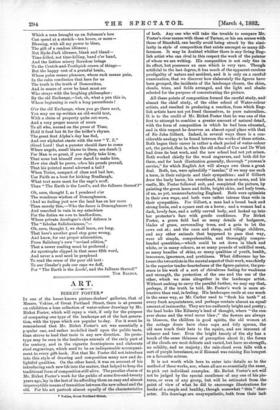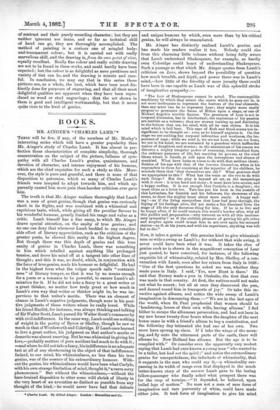ART.
BIRKET FOSTER* IN one of the lesser-known picture-dealers' galleries, that of Messrs. Vokins, of Great Portland Street, there is at present on exhibition a loan collection of water-colour drawings by Mr. Birket Foster, which will repay a visit, if only for the purpose of comparing one type of the landscape art of the last genera- tion, with the types which are popular to-day. For it must be remembered that Mr. Birket Foster's art was essentially a popular one, and rather modelled itself upon the public taste, than strove to lead that taste in any new direction. Its proto- type may be seen in the landscape annuals of the early part of the century, and in the vignette frontispieces and elaborate steel engravings, which used to be an indispensable accompani- ment to every gift-book. Not that Mr. Foster did not introduce into this style of drawing and composition many new and de- lightful qualities. On the other hand, it was on account of his introducing such new life into the matter, that helped to keep the traditional form of composition still alive. The peculiar charm of Mr. Birket Foster's work for the public of some five-and-twenty years ago, lay in the fact of its affording them an easy and almost imperceptible means of transition between the new school and the old. For his art partook almost equally of the characteristics
• 'Yoking, Great Portland Street.
of both. Any one who will take the trouble to compare Mr. Foster's river scenes with those of Turner, or his sea scenes with those of Stanfield, can hardly avoid being struck by the simi- larity in style of composition that exists amongst so many dif- ferences. It may be doubted whither there is any living Eng- lish artist who can rival in this respect the work of the painter of whom we are writing. His composition is not only fine int its effect, but possesses an ease which is very rare. Though artificial to the last degree, it has much of the apparent careless. prodigality of nature and accident, and it is only on .a careful( examination, that we discover how elaborately the figures have- been grouped, the incidents of the landscape chosen, the skies,. clouds, trees, and fields arranged, and the light and shade;- selected for the purpose of concentrating the picture.
All these points of composition formed the careful study, and almost the chief study, of the older school of Water-colour artists, and resulted in producing a reaction, from which Eng- lish artists have not yet freed themselves, to pure naturalism.. It is to the credit of Mr. Birket Foster that he was one of the first to attempt to combine a greater amount of natural detail,. with the form of composition in which he had been educated,. and in this respect he deserves an almost equal place with that of Sir John Gilbert. Indeed, in several ways there is a con- siderable analogy to be found between the works of these artists.. Both began their career in rather a slack period of water-colour- art, the period, that is, when the old school of Cox and De Wint had done its best work, and the new school had not yet arisen._ Both worked chiefly for the wood engravers, and both did for them, and for book illustration generally, thorough " yeoman's_ service," for which English Art will always owe them a great deal. Both, too, were splendidly " insular," if we may use such a term, in their subjects and their sympathies; and if Gilbert drew the burly baron, his sweetheart, his men-at-arms, and his castle, Mr. Foster followed snit, and completed the picture, by painting the green lanes and fields, bright skies, and leafy trees,.
of an, as yet, unmanufacturing England. Both were optimists in their own ways, and both were rather intense than wide in their sympathies. For Gilbert, a man had a broad back and strong limbs, and a square seat on a horse ; and a woman had a dark, lovely face, and a softly carved body, and looked up into her protector's face with gentle confidence. For Birket Foster, a green field had so many details of hedgerow,. blades of grass, surrounding trees, and a gate to let the cows out at ; and the oxen and sheep, and village children,. and any other animals that happened to pass that way, were all simple, comprehensible, and thoroughly compre- hended quantities,—which could be set down in black and white, or in many colours, as so many pounds of unkilled meat,. so many bundles of skins, so many qualities of youth, health,.
innocence, ignorance, and prettiness. What difference lay be- tween the two artists in the mental aspect of their work, was chiefly in the superior tender-heartedness of the figure-painter, the pre- sence in his work of a sort of chivalrous feeling for weakness and -strength, the protection of the one and the use of the other, which we miss altogether in the landscape artist..
Without seeking to carry the parallel farther, we may say that,. perhaps, if the truth be told, Mr. Foster's work is more at- tractive than real, in feeling. His landscapes smile at one much in the same way, as Mr. Carker used to " flash his teeth " at every fresh acquaintance, and perhaps contain almost an equal
amount of insincerity. They are too uniformly bright and pretty;. the land looks like Kilmeny's land of thought, where " the sun, ever shone and the wind never blew ;" the flowers are always in blossom, the children in good spirits, the old women at the cottage doors have clean caps and tidy aprons, the- old men touch their hats to the squire, and are innocent of tobacco and beer. Even the bright beauty of the sky has a. touch of the same thinness of perception about it ; the forms of the clouds are most delicate and varied, but have no strength,. no solidity, and no majesty; the rain-cloud even falls with a sort of purple luxuriance, as if Rimmel was raining Ess bouquet on a favourite actress.
It is not worth while here to enter into -details as to the• method of these works, nor, where all are so essentially the same,.
to pick out individual examples. Mr. Birket Foster's art will not be judged by the special excellence of any one of his pic- tures, or even of any group, but will be estimated. from the point of view of what he did to encourage illustrations for books of a simple and healthy, though somewhat " thin " char- acter. His drawings are unsympathetic, both from their lack of contrast and their purely recording character; but they are 'neither ignorant nor inane, and as far as technical skill .of hand can go, they are thoroughly accomplished. The 'method of painting is a curious one of mingled body- and-transparent colour; but it is carried out with really marvellous skill, and the drawing is, from its own point of view, -equally excellent. Really fine colour and really subtle drawing are not to be found in these works, and could hardly have been expected; but the colour is as delightful as mere prettiness and variety of tint can be, and the drawing is minute and care- ful. In conclusion, we may say that in this series those pictures are, as a whole, the best, which have been most dis- tinctly done for purposes of engraving, and that all their most delightful qualities are apparent when they have been repro- duced as wood or steel engravings ; that the art shown in -them is good and intelligent workmanship, but that it never quite rises to the level of genius.



































 Previous page
Previous page